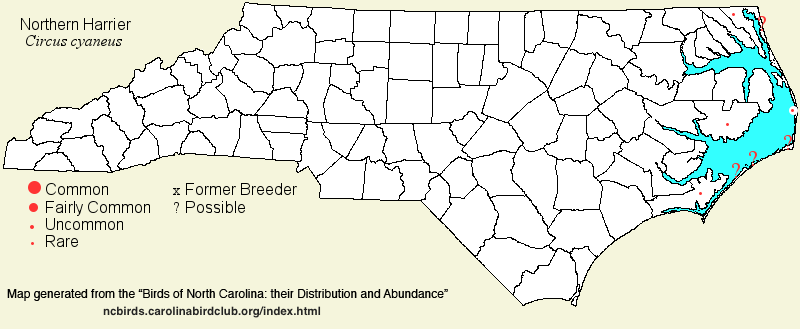 |  |
|
Northern Harrier - Circus hudsonius ACCIPITRIDAE Members: | Search Common: Search Scientific: |
|
|
|||||||
| General Comments |
The Northern Harrier is our only regularly occurring hawk that is strictly tied to marshes and fields, completely avoiding wooded areas. It is one of our rarest breeding species, and whether it nests each summer is open to question, even though a few adults are seen in some coastal marshes in midsummer. Fortunately, there are several documented breeding records. Nonetheless, one cannot assume local breeding by simply observing an adult in June. The species is best known as a wintering bird over the extensive coastal marshes, and numbers have shown a slight decline there, presumably owing to declining nesting habitat on its breeding grounds in Canada and the northern states. The species also migrates through the state and winters in many areas, but extensive grasslands/meadows/marshes are clearly declining inland, and thus wintering numbers have been decreasing in recent years, especially in the Piedmont. The species is most numerous over extensive salt and brackish marshes, and also over extensive fresh marshes and fields near the coast.
In 2017, the AOS (now named the American Ornithological Society) split the Northern Harrier off from the Old World taxon, into two species. The New World form changes its name from Circus cyaneus to Circus hudsonius. | ||||||
| Breeding Status | Breeder | ||||||
| NC BRC List | Definitive | ||||||
| State Status | SR | ||||||
| U.S. Status | |||||||
| State Rank | S1B,S4N | ||||||
| Global Rank | G5 | ||||||
| Coastal Plain | Migrant, winter resident, and sparse breeder; somewhat declining. Rare and poorly known breeder near the coast, south to Cedar Island. Fairly common and widespread along the coast and in the Tidewater zone, from mid-Sep to mid-Apr; uncommon through May and beginning in mid-Aug, but rare in Jun and Jul. One or two pairs nest, at least sporadically, at Pea Island, Cedar Island, Mattamuskeet NWR, Mackay Island NWR, and perhaps a few other places. Farther inland, generally uncommon migrant and winter resident; mostly Sep through Apr. One lingered at the Voice of America site in Pitt all summer 2023, but there was no suggestion of nesting. Peak counts: 65, Alligator River NWR, winter 2001-02; | ||||||
| Piedmont | Migrant and winter visitor/resident, declining. Rare to uncommon over the entire province from mid-Sep to early May, slightly less numerous in winter as compared with spring and fall; a scattering of summer records, but very rare at that season, and does not nest. There are no known regular wintering locales in the province. Peak counts: 98, Jordan Lake (when the lakebed was weedy and had not yet filled with water), 4 Jan 1981. | ||||||
| Mountains | Migrant, and scarce winter visitor, probably declining. Rare spring migrant, mainly in May; very rare in fall, and seemingly very rare to casual in winter. Generally at low elevations, below 2,500 feet. Peak count: 3, Black Balsam Knob in Shining Rock Wilderness (Haywood), 3 Oct 1983. | ||||||
| Finding Tips |
This species is usually easily found near the coast at extensive marshes or extensive fields, from Oct through Mar and into early Apr. **** | ||||||
| Attribution | LeGrand[2023-10-20], LeGrand[2023-03-20], LeGrand[2017-07-07] | ||||||
| NC Map Map depicts all counties with a report (transient or resident) for the species. | Click on county for list of all known species. |
| NC Breeding Season Map Map depicts assumed breeding season abundance for the species. |  |